January 8, 2024
How to Stage a House for Sale
Thinking about selling your home? If so, have you considered staging to make your house more appealing to potential buyers?
According to a 2021 Real Estate Staging Association report, 85% of staged homes sold for 5% to 23% over the listing price.
According to real estate agents, staging a home makes it easier for potential buyers to imagine the property as their future home.
So, staging your home can make for a more enjoyable and seamless experience for buyers. It can also help you get more favorable results during the sales process.
This ultimately allows for a faster and more successful sale.
What Is Staging a House?
Home staging involves preparing your home for a potential buyer. This could mean redecorating, rearranging furniture, adding new furniture, de-cluttering, or cleaning to present your home in the best possible light.
You can choose how far you want to go with staging. You can keep things simple by making small but meaningful changes like a fresh paint color or new window treatments.
Or, you can make more drastic adjustments, like adding new living room furniture or enhancing curb appeal with new landscaping.
Either way, staging your home can make it look more move-in-ready. As we said earlier, it can help potential buyers imagine themselves living on the property more easily.
That’s because staging your home involves removing clutter, personal items, or other items that may turn off a buyer.
According to the NAR, real estate staging is the final push buyers need to help them envision the home as “theirs.” And 47% of buyer’s agents say that staging positively affects most buyers’ opinions of a home.
This can play a big role in helping the home sell faster.
Need help envisioning what a staged home looks like? Check out this screenshot from a quick Google image search.
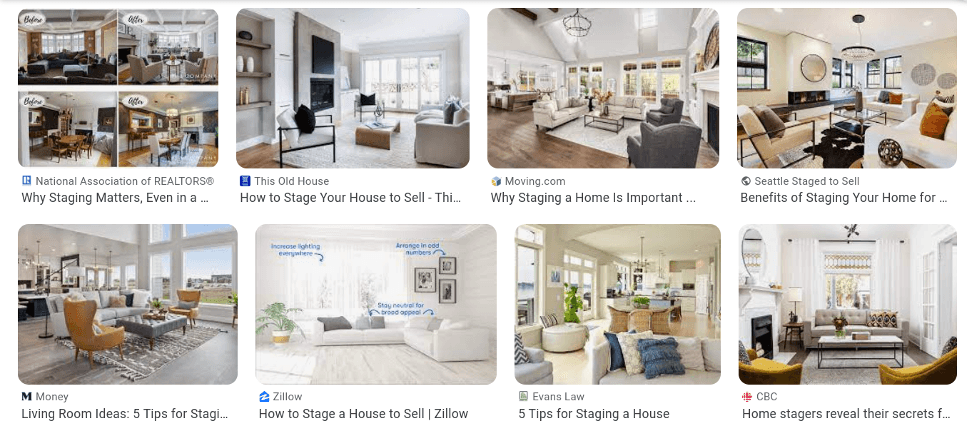
Screenshot provided by the author
Before
After
Why Should You Stage Your Home for Sale?
Not convinced staging your home could make a big difference in the selling process?
Consider these statistics:
-
According to 50% of real estate agents, staging a home increases a home’s sale price by 1% to 10% on average.
-
22% of sellers’ agents saw a 1% to 5% increase in staged homes than those that weren’t staged.
-
Staged homes spend 73% less time on the market than non-staged homes.
-
Home staging brings in an 8% to 10% ROI.
Preparing to Stage
Now that you’re convinced of the benefits of home staging, let’s talk about how the process works.
Professional Home Stager or Do it Yourself?
As you prepare to stage your home, you might be stuck deciding whether you want to do it yourself or hire a professional.
To help you make a decision, let’s consider the pros and cons of each.
Pros of DIY home staging:
-
Save money: The most obvious benefit of DIY home staging is cost. There are many expenses that go into selling a home. So, saving on any of those expenses is a plus. Of course, you must purchase the furniture or materials you use. But you end up saving by not hiring a professional stager.
-
More control: DIY home staging can be advantageous for homeowners because it allows them creative freedom in how they want to stage their home. It’s completely up to you if you want to get rid of or keep certain items. And it’s your choice when it comes to how you want to rearrange your furniture.
Cons of DIY home staging:
-
Time-consuming: As a homeowner looking to put your property on the market, you’re probably dedicating your time to all sorts of projects. For example, you may be juggling between getting repairs and maintenance, obtaining property records, or meeting with your real estate agent. DIY home staging is another time-consuming task to add to the list as you look for the right furniture pieces, figure out the right furniture placement, and de-clutter and clean your home.
-
Potential complications: Many things may go wrong or not go as planned when staging your home. For example, you may have a large home or a complicated layout, making staging difficult.
Pros of hiring a professional home stager:
-
Experience and expertise: Professional home stagers have years of experience in staging homes, which means they know the ins and outs of the process. They know what works and what doesn’t when it comes to making homes appealing to buyers.
-
Potential ROI: Even though you’re paying for a professional to stage your home, you could potentially see a return on your investment if your home sells at a higher price.
Cons of hiring a professional home stager:
- Overhead costs: The overhead costs of professional home staging can mean higher fees for homeowners. For an initial design consultation, the cost ranges between $300 to $600, according to Realtor.com.
Virtual Staging
If you’d rather not work with a professional stager, you might consider virtual staging real estate. The cost and turnaround of virtual staging are a fraction of either professional home staging or DIY.
With virtual staging, you just take a picture of an empty room using your smartphone, and AI-powered software will generate an image of a fully furnished room.
Here’s an example from Virtual Staging AI.
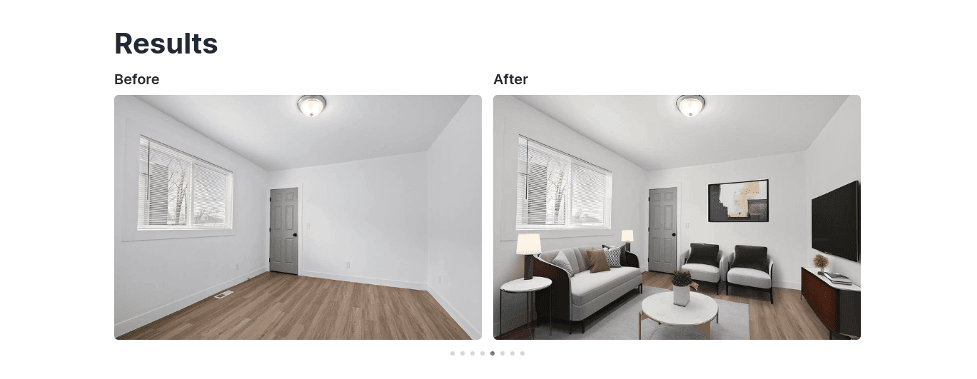
De-Cluttering and Cleaning
Whether you choose to work with a professional stager or do it yourself, it’s important to clean and de-clutter your home.
This will give you a clean slate, allowing you to design your home in a neutral way that appeals to most buyers.
Pack up each room by about 30% to de-clutter and depersonalize your home. Remove your personal items, such as family photos and heirlooms. Here’s a great example of a room that needs de-cluttering.
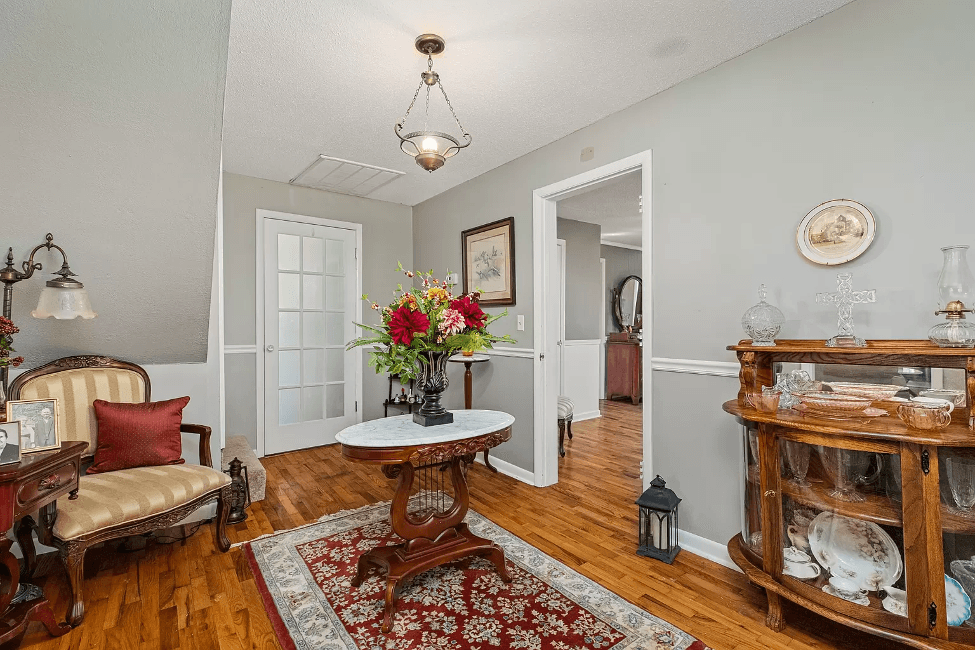
De-clutter flat surfaces. That means clearing off countertops and tables for a clean, minimal look. Organize your storage areas, including closets and cabinets. If you’re running out of space, consider using a storage locker to create extra space or hide unwanted furniture.
Virtual Staging Tip: With Virtual Staging AI’s newest update, you can de-clutter and remove unwanted furniture with the click of a button. Talk about convenience! Try it for free!
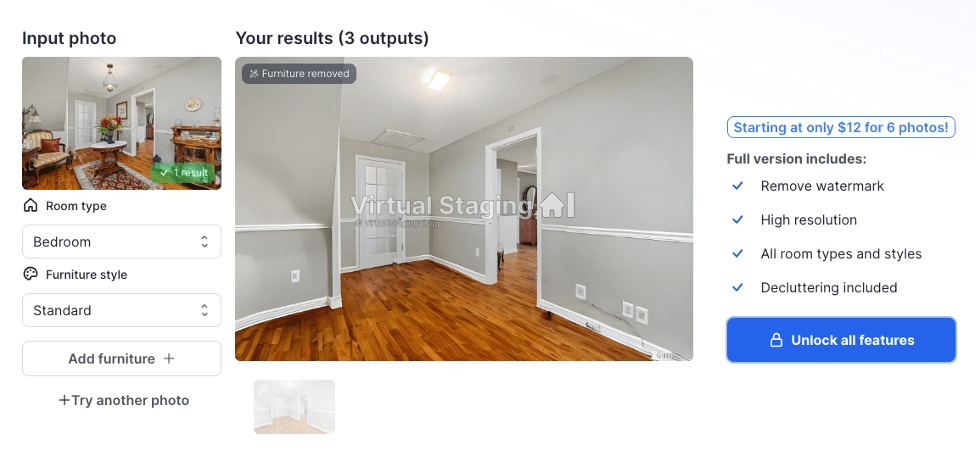
Virtual rendering by Virtual Staging AI
When it comes to cleaning, consider hiring a professional cleaning company to deep clean your home. Removing dust, dirt, and grime can showcase and bring out your home’s best features. Clean surfaces, windows, and fixtures create a more polished, attractive look.
You may be able to achieve these results yourself, but there’s nothing like a professional cleaner’s touch to make your home look like new.
Small Repairs
Before staging, you also want to make sure your home is in tip-top shape.
The most common improvements homeowners make before selling their home include:
-
Fixing loose or sticking cabinet doors
-
Repairing or replacing leaking pipes
-
Addressing electrical issues
-
Patching holes in the wall
-
Upgrading light fixtures
-
Fixing leaky faucets
-
Repairing gutters
While you’re taking care of repairs, make sure to clean and touch up baseboards, door knobs (cabinet handles and drawer pulls), and grout. Also, repair sticky doors or windows.
It’s also important not to go overboard on repairs. Not all home improvements bring a significant return on investment.
So, only focus on repairs that add value to your home. Plus, going overboard with personalized upgrades could turn off some buyers and limit your home’s marketability.
Neutral Colors
If your home features a lot of rich colors and hues, consider toning things down a bit.
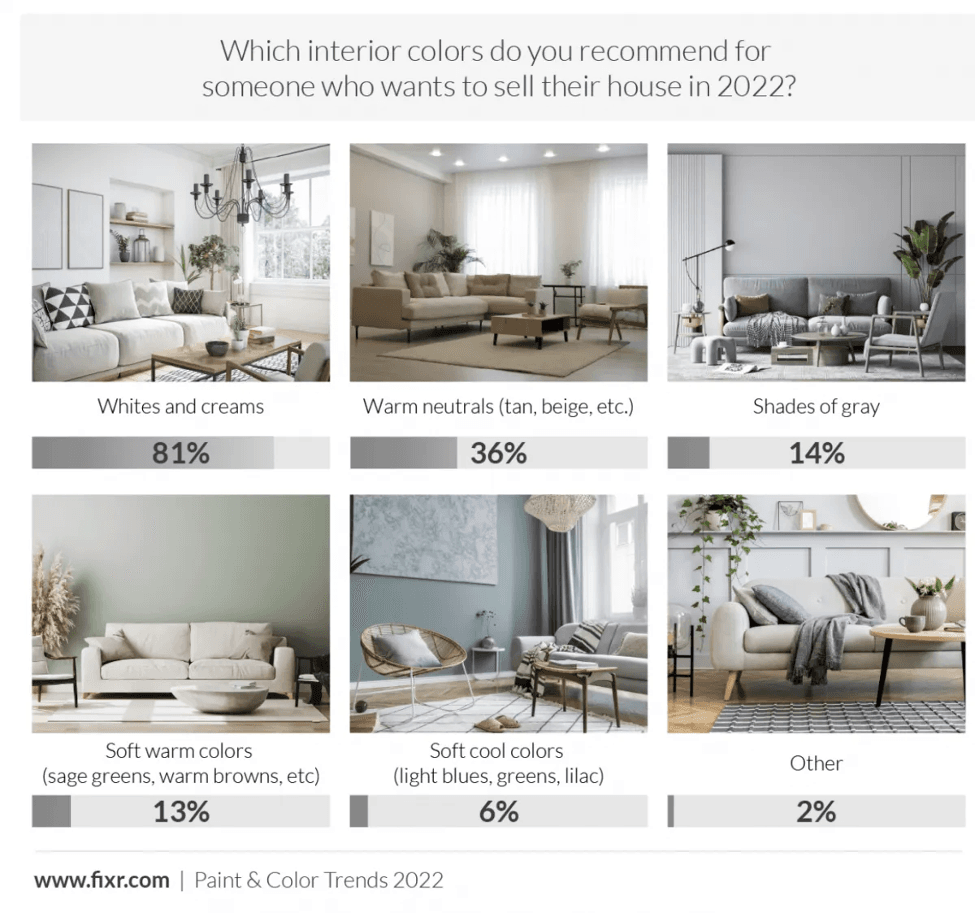
Consider painting your walls and getting furniture in neutral colors like white, cream, beige, or light gray. Using neutral colors allows you to appeal to more potential home buyers.
Maximizing Visual Appeal
Enhance the visual appeal of your home with different pieces of furniture, decor, lighting, plants, and pops of color.
Pieces of Furniture
Essential pieces of furniture to place for home staging include:
-
Dining tables and chairs
-
Beds with nightstands
-
Bookcases
-
Couches
Prioritizing these larger pieces to fill empty spaces can help you avoid making the room feel cramped or barren.

Be sure to give each room a clear purpose to help buyers envision themselves living in the space.
Throw Pillows, Rugs, and Light
Incorporate throw blankets and pillows using different colors and textures to add a cozy touch to your home. Also, remove rugs to open up the space. Or, you can clean or replace rugs to maintain a fresh appearance.
Optimize lighting in the space to create a warm and inviting atmosphere. Consider using layered lighting with fixtures like pendant lights and floor lamps.
Choose bulbs with a warm tone and strategically place lighting to highlight focal points, such as kitchen countertops, dining tables, artwork, and architectural features.
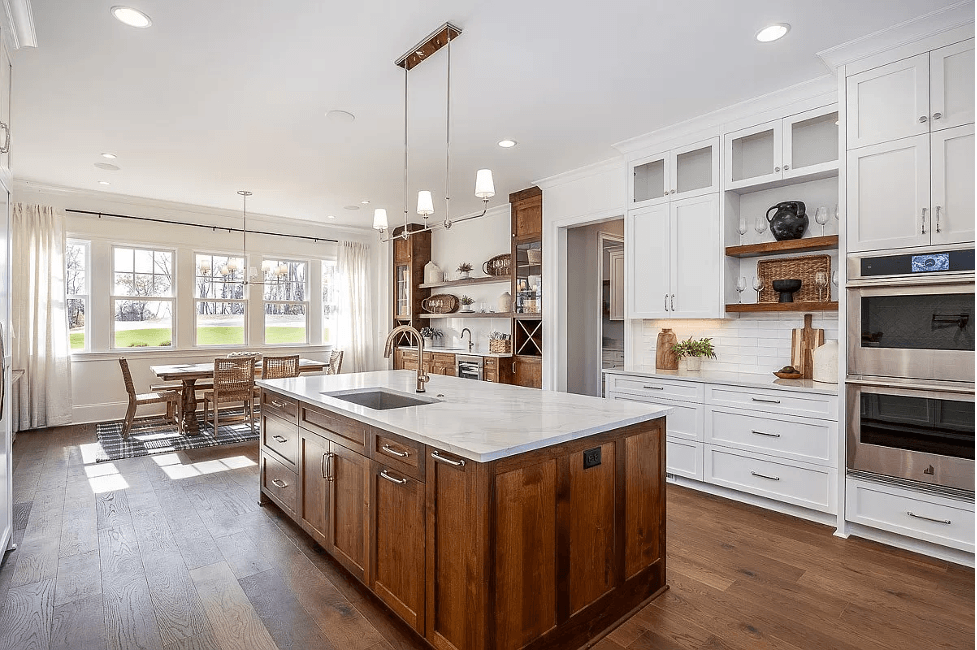
Also, ensure proper lighting in entryways, living spaces, and bedrooms to create a balanced and welcoming ambiance.
Use mirrors to enhance the natural light in the home and give the feeling of a larger space.
Potted Plants, Fresh Flowers, and Pops of Color in Accessories
Greenery is another element to consider when staging your home. Potted plants and fresh flowers can fill empty spaces and add color. Greenery can also make your spaces more inviting and pleasant.
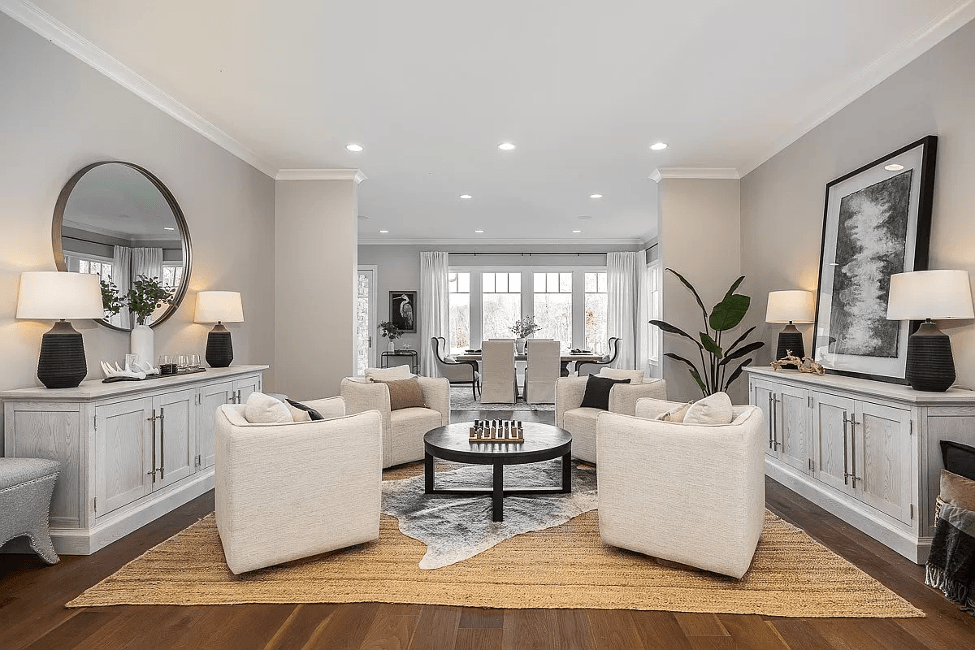
You can also use colorful items like throw pillows, artwork, and other decor to add extra pops of color.
Before
After
Kitchens and Bathrooms
Kitchens and bathrooms are some of the most important rooms when it comes to selling properties.
Mid-range kitchen renovations can bring an 80% ROI, while upper-end bathroom renovations can result in around a 60% improvement in the value of a home.
Cabinets and Storage
Consider updating your kitchen and bathroom cabinets with a fresh coat of paint and new hardware.
Organize storage spaces to maximize space and appeal to potential buyers. It’s important for these areas to be as tidy and as minimal as possible. If they’re too cluttered, it could take away the space’s overall appeal.
Pro Tips
Below are some bonus tips to help you stage your home to achieve a higher ROI.
Stage Like Your Home is a Hotel
Think of a hotel room. When you walk into a luxurious hotel, you’ll notice inviting neutral tones and strategically placed furniture pieces that appeal to different guests. This is how you should envision staging your home.
Put yourself in the shoes of potential buyers. Think about what you can do to create a comfortable and inviting environment.
The photos you take of your home after staging should look like the photos you take of an upscale hotel room. Removing items in your home that you typically wouldn’t see in a hotel during staging is probably best.
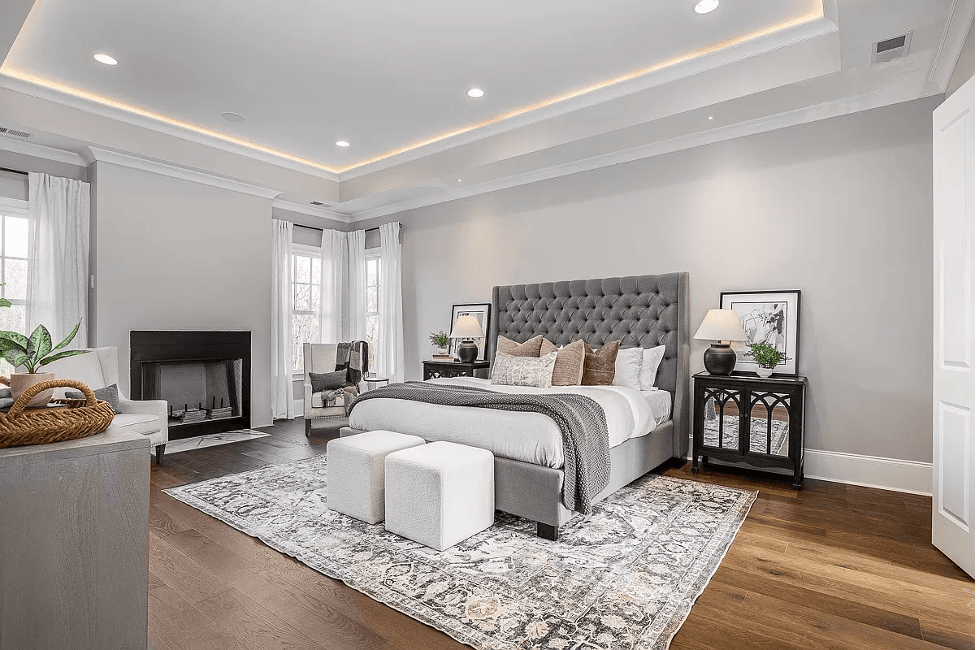
Here are some tips for staging your home like a hotel:
-
Add small luxury touches like fresh flowers or decorative towels
-
Invest in quality bedding and linens
-
De-clutter and simplify decor
-
Create a cozy seating area
-
Use a neutral color palette
Compare Your Home to Recent Listings Near You
A big part of the home-selling process is knowing your competitors. So, research the recent listings in your area and compare them to your home.
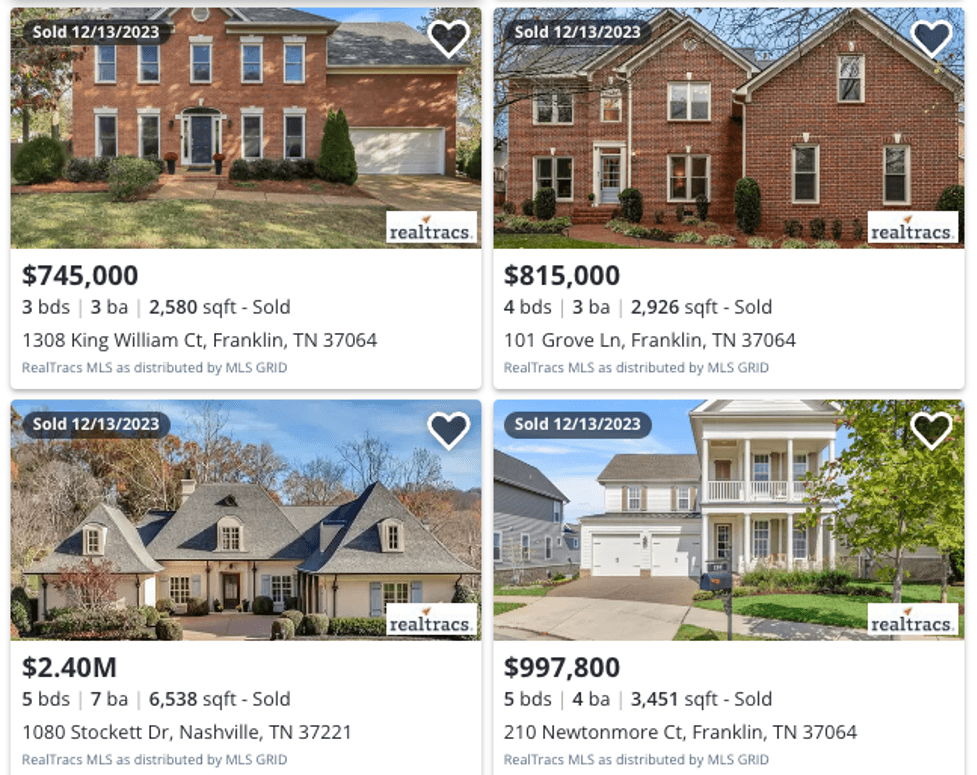
Screenshot provided by the author
What repairs have been made? What does the staging process look like?
Be sure to pay attention to homes that sold for higher prices and those that sold for lower-than-average prices to identify any patterns and potential influencing factors.
You can adopt some of the most successful strategies to achieve the best results.
Perfect the Art of Home Staging for a Successful Sale
A key point to remember about staging a house for sale is implementing design elements that appeal to as many potential buyers as possible.
From removing clutter and using minimal furniture pieces to using neutral tones and adding pops of color, staging a home involves thoughtful design choices and strategic presentation to create a cohesive and inviting atmosphere.
You might see a higher ROI and a faster sale with the proper staging setup.
But choosing between DIY staging, a professional stager, and virtual staging for real estate can be challenging. While DIY home staging gives you more control, it’s also a bigger time commitment.
Hiring a professional stager helps save you time, but cost may be an issue if you’re on a budget.
Lastly, virtual staging with AI is even easier than hiring a professional stager — your home doesn’t even have to be empty. You can enjoy lower costs and higher ROI.
Try Virtual Staging AI for free now to get stunning, virtually staged property photos in seconds.